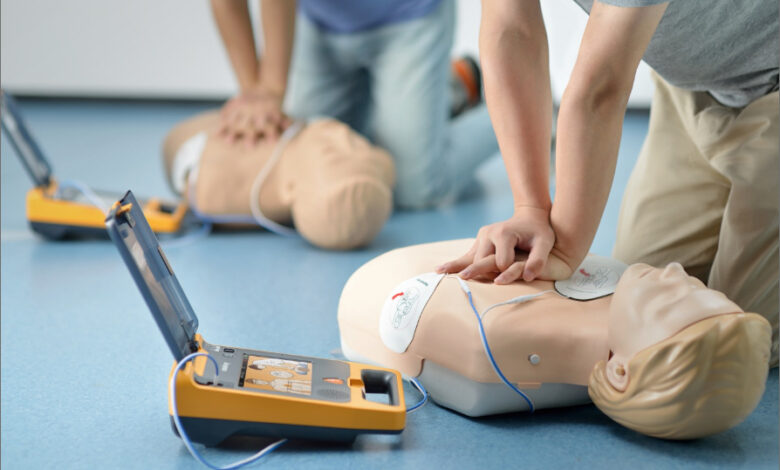Maximizing Survival: Connecting CPR and AED Use Quickly

Introduction
When a person experiences a sudden cardiac arrest, every second counts. The faster CPR (Cardiopulmonary Resuscitation) and an AED (Automated External Defibrillator) are applied, the higher the chances of survival. In this article, we’ll explore how to maximize survival by efficiently combining CPR and AED use, and why knowing the right steps to take is critical. By learning how to act quickly and confidently in a cardiac emergency, you can make a life-saving difference. CPR NOW offers easy online training to help you master these essential skills—visit the website to get started today.
The Critical Role of CPR and AED in Cardiac Arrest
Cardiac arrest occurs when the heart suddenly stops beating effectively, and blood stops circulating to vital organs like the brain and heart. When this happens, survival depends on immediate action:
- CPR: Chest compressions keep blood flowing to the heart and brain, which is essential in the early stages of cardiac arrest.
- AED: The AED delivers a controlled shock to restart the heart when necessary, helping to restore a normal heart rhythm.
Combining CPR and AED use in the first few minutes of cardiac arrest significantly increases the chances of survival. The quicker these steps are initiated, the more likely the person will survive with minimal brain damage.
Why Quick Action Matters
In a cardiac arrest situation, the brain starts to suffer irreversible damage after just a few minutes without oxygen. By the time emergency medical services arrive, it could be too late if CPR and AED use haven’t been initiated. Here’s why every second is crucial:
- CPR buys time: While CPR keeps blood circulating, it can only do so much to restart the heart. An AED is needed to restore the heart’s rhythm.
- AED effectiveness: An AED can significantly increase the chances of survival if applied within the first 3-5 minutes of cardiac arrest. (heart.org)
- Brain damage: Without CPR and AED intervention, the lack of oxygen to the brain after just 4-6 minutes can result in permanent brain damage or death.
The faster you can combine CPR and AED, the better the chance of saving a life and minimizing long-term health impacts.
How to Perform CPR and Use an AED Quickly
In an emergency situation, it’s important to act without hesitation. Here’s a step-by-step guide to combining CPR and AED use efficiently:
1. Assess the situation
- Check for responsiveness: Gently shake the person or call their name. If they don’t respond, check for breathing.
- Call for help: Have someone call emergency services immediately or do it yourself if you’re alone. The sooner professional help arrives, the better.
2. Start CPR
- Chest compressions: Place the heel of one hand on the center of the chest, just below the breastbone. Place your other hand on top, interlock your fingers, and begin compressions.
- Push hard and fast—at least 2 inches deep at a rate of 100-120 compressions per minute.
- Allow full chest recoil between compressions.
- Rescue breaths (optional): If you’re trained and able, give 2 rescue breaths after every 30 compressions.
3. Use the AED
- Turn on the AED: As soon as the AED is available, turn it on and follow the voice prompts. Most modern AEDs guide you through the process.
- Place the pads: Attach the pads to the person’s chest, ensuring they’re placed on the upper right and lower left sides of the chest (check the diagram on the AED).
- Analyze the heart rhythm: The AED will analyze the person’s heart rhythm and tell you if a shock is needed.
- Deliver a shock (if prompted): If the AED advises a shock, press the button to deliver it. After the shock, immediately resume chest compressions.
4. Continue until help arrives
- Keep performing CPR and using the AED as directed. If the person starts breathing normally, place them in the recovery position and monitor their condition.
- If they don’t respond and emergency responders arrive, continue your efforts until they take over.
Key Takeaways for Maximizing Survival
- Act quickly: Start CPR immediately after confirming the person is unresponsive and not breathing. The faster you start, the better.
- Get an AED: If an AED is nearby, don’t wait—use it as soon as possible.
- Minimize interruptions: Keep CPR going with minimal pauses. If an AED is used, resume chest compressions immediately after the shock.
- Training is essential: Knowing how to perform CPR and use an AED effectively can make the difference between life and death. Take an online course to become prepared.
Why Training is So Important
Having CPR and AED knowledge is crucial because it enables you to respond quickly and confidently during a cardiac emergency. Without proper training, it’s easy to hesitate, which could cost valuable time. By becoming certified in CPR and AED use, you’ll be ready to act and save lives.
CPR NOW offers online training courses that teach you exactly how to perform CPR, use an AED, and handle emergencies with confidence. Visit the website to get started today and ensure that you’re prepared to act when it matters most.




